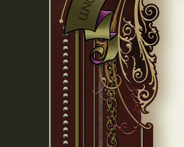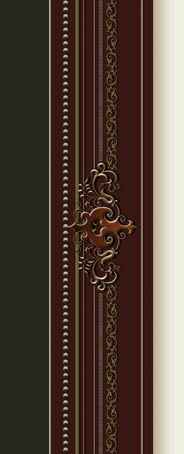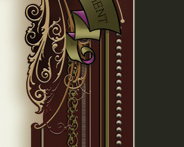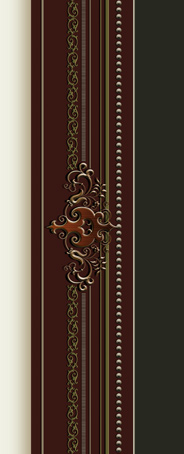
It is with great sadness that we announce that our good friend and colleague Arthur Vanson passed away April 3rd after a long struggle with cancer. Arthur came on board with Letterhead Fonts in 2002 with his traditional roman Essendine and as recently as last month, we were discussing adding swashes to his Flash Script font. Besides being a talented signwriter and lettering artist, Arthur was also gifted when it came to the technical aspects of creating fonts, insisting on doing all of his own FontLab work. His constant striving for perfection encouraged me to scrutinize my own work harder. He was a soft-spoken man who epitomized old fashioned English graciousness. He will be sorely missed.
--Chuck
Here's a portion of a Q & A Arthur did with us back in 2006...
Q: I know that your father influences your work alot, what do you think he would have said about your fonts today?
Arthur: He was never anything but enthusiastic and supportive, so I guess he would be pleased to see them, though, no doubt spooked a little by how similar my lettering is to his and the whole process of a machine mimicking his own lettering. (He died in 1964, a year after I left school at fifteen).
Q: Who are some other people that have influenced your work?
Arthur: Primarily Cecil Wade (see Arthur's "Wade Grotesque" font). Eric Norman changed the way I write Trajan (see Arthur's "Essendine" font ), the soft corners on lower limb terminators are his, as are the inside radii on the L and E etc. He was acknowledged locally as the true master of Old English lettering and devised new shapes and forms at will. I also worked with Brian Walker for some time and learned to loosen up a bit on my very formal layouts; and I loved the way he used colours. Clearly he was influenced by his training under Percy Brown, who was a showcard or ticket writer.
Q: How do you find fonts to create? Do you have a large collection of books or other material?
Arthur: Chesham Sans, American Sans, Essendine, Tallington, and Speedstyle were my stock, freehand, no-reference lettering styles. They were all varied heavily to suit any particular job, in some cases their origins would be almost unrecognisable to a non-signwriter. One of the downsides of making computer fonts is the necessity of 'fossilising' a style. Tallington and Speedstyle have a number of Wade characteristics which I've added. I occasionally painted Opening Night and Wade Grotesque but would need to refer to his source book at times. The letters of Hindlewood were devised for a housename and the entire alphabet was extrapolated from those few letters, my time working with Eric Norman shows up both in this font and Stratford which was also designed for a single job - Stony Stratford Antiques; having said that some of the characters are pure Cecil Wade. The origins of Stevens Percepta are self evident - Optima via Mike Stevens. Eric Norman took the Signs of the Times magazine for a while and cut out a number of plates which he passed on to me. Cincinnati Poster is taken directly from one, I wonder if it might be one of the Alf Becker styles?
Until I found Mike Jackson's list of favourite books I only had a couple of Cecil Wade books and an ancient Dellamott. Since then I've been steadily collecting books from Mike's list and a few others.
Q: Can you describe, briefly, the process of how you go about making a font?
Arthur: Originally I would paint the whole alphabet, digitise it and make the font for my Gerber software. Now I paint a few 'ruling' letters and extrapolate the rest of the font from them, on the computer. The font is then assembled into Fontographer with spacing and kerning applied.
Q: What are some of your favorite typefaces and why?
Arthur: Invariably, I am attracted to signwriterly lettering, this makes no compromises to look good at tiny point sizes, nor can one expect every word to look good. If the shape of a word is not pleasing or certain letter combinations are not coherent, then one should have the wherewithal to adapt letters to taste or choose another style. If all letter combinations work well together you can bet too many compromises have been made and the lettering will be stilted and lifeless. Great for printing; but not so hot for larger than life signage. Most of the Lettterhead, Art and Sign and SignDNA output is good in this respect.
Some useful printers typefaces in no particular order:
Isbell, Squire, Letraset Graphis, Futura Display, Gill Sans, Trajan, Blair, Cooper, Copperplate Gothic, Belwe, Benguiat, Friz, Fatso, Neil Bold, Microgramma, Frutiger, Larissa, Impact, Sloop. I love Helvetica, quite simply 'works'. It's only crime is it's popularity!
Q: In what ways does signwriting in England differ from the US?
Arthur: Can't speak for the whole of English signwriting, but the bulk of my work and my Father's was very formal compared to what I see of American sign painting. I never developed a stock script because there was never enough call for one. No doubt if I'd had one I could have found a use for it, but on the very odd occasion where I felt it necessary, I would adapt a copperplate script to suit. The fabulous casual scripts I see coming from the US and Australia are a real treat and, I guess, would only have been matched over here, by ticket, showcard and poster writers.
Q: I really like the Stratford font. It's unusual as far as Old English styles go. Can you tell me how that one came about?
Arthur: Retracing old ground here a little, but I wanted to do a glass panel for a friend who has a shop called Stony Stratford Antiques. Old English was the obvious choice but I wanted something with more verve and legibility. I tried various things and wasn't happy with them. So fell back on the ever reliable Mr Wade's books, combining a number of his ideas and shapes some of my own.
Q: Do you have any fonts in the works or that you would like to do?
Arthur: I would love to interpret a whole slew of fonts suggested by some more of Cecil Wade's ideas. To me he was the ultimate lettering artist.
See Arthur's work at: http://www.buckssigns.co.uk























